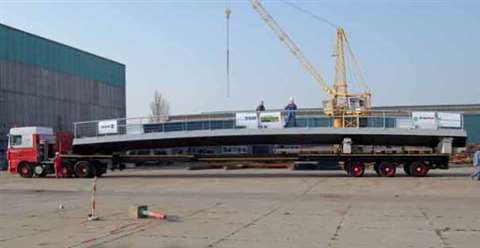Lighter move
18 March 2008

The dimensions of the new bridge suggested that it was heavy enough to need both heavy duty trailers or transporters and high capacity cranage.
This was not the case. The ready-for-use bridge reached its destination by road, straight from its manufacturing location in Rotterdam, the Netherlands. This is normally a distance of about 150 km but “straight”or “direct”do not describe the route. The bridge made a “little”detour via Paris, France, all by road and on the same three axle double extendable and steering trailer. There was no overloading. The additional distance of more than 1,000 km took six days and crossed Paris at night. And not because of the suitable route.
The bridge manufacturer, FiberCore Europe, claims that the 12 tonne structure is the world's largest carbon composite bridge. It was presented at the JEC fair in Paris, an exhibition showcasing innovations in fibre reinforced polymers, including carbon composites, that are making a breakthrough in the building industry. DSM Resins, supplier of the resin used in the bridge, facilitated the presentation at the exhibition.
Bridge data
The weight of the new composite bridge is about 30 times less than a comparable concrete bridge, FiberCore claims. Additional information on carbon composites provided by FiberCore includes a claim that in terms of payload versus its own weight for the new carbon composite bridge it is 6.0 x, whereas for steel it is 1.0 x and 0.3 x for concrete. The material is lightweight, stronger than steel and has a virtually indefinite lifespan, the company says. The new bridge was tested with a 75 tonne test load equally spread.
It is also stated that building with composites is an effective answer to global warming. Production of concrete and steel contribute to this environmental problem and bridges made of composites do not have these drawbacks and can even yield carbon dioxide credits, according to FiberCore.
With its free span of 24.5 m the bridge illustrates the possibilities of composites and they can be produced and used in many shapes. The bridge can be produced in series so it can be cost-competitive with traditional steel and concrete materials. Production of composite bridges kickstarts a high technology development in the normally conservative construction sector.
The revolutionary technology can be employed in all sorts of load bearing structures, including road roofing, piers, bridge widening or balconies. According to FiberCore Europe, the application of carbon fibre technology means that the composites industry has a splendid opportunity to penetrate the construction sector.
This development could have a major effect on the requirement to use heavy duty trailers and heavy cranes versus more specialized trailers and lighter cranes. In addition, it could further boost the pre-fabrication of complete bridges and other structures, resulting in an overall increase in the requirement for specialized transport and cranage services.
All these advantages of carbon composite materials and, especially, the strength for low weight, prompt the question whether those materials could also be used in the manufacture of specialized trailers. In that way tare weight would be reduced and load capacity would increase.




